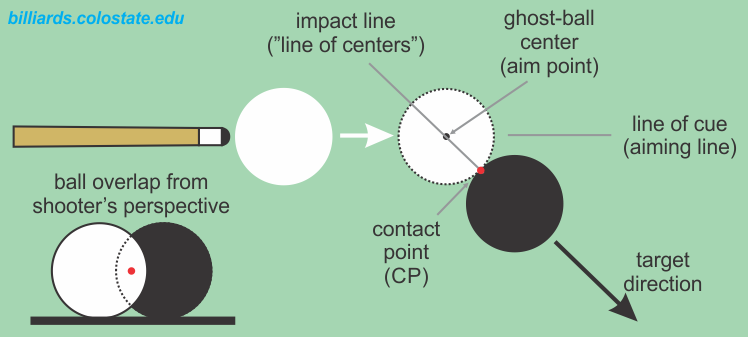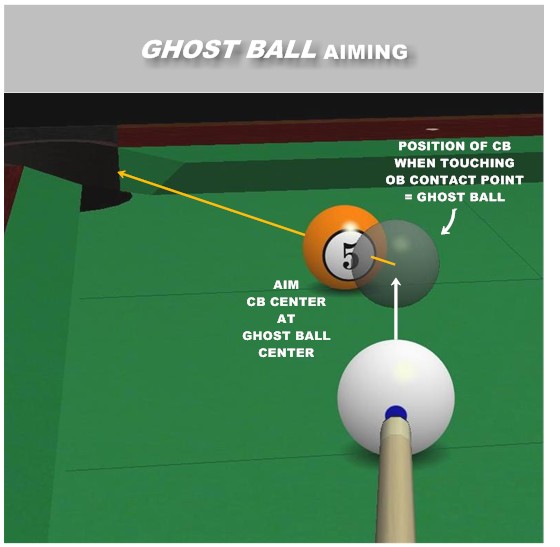How does ghost-ball aiming work?

The ghost ball (GB) is the imaginary position the CB must be, at contact with the OB, to make a shot. It is easy to practice visualization of the GB target by having a helper place a real ball in the desired GB location (adjusted for throw or not) and pull it away when the person shoots. I demonstrate this technique in NV 3.1; although, I didn’t have a helper to remove the ball for me. Also, striped balls are useful to help the shooter visualize both the “aiming line” (from the CB to the GB center) and the “impact line” between the GB and OB centers. To me, that’s the most useful advice in the video.
Below are video demonstrations of how you can use the cue to help you aim using the ghost ball. The first is from Vol. II of the Billiard University (BU) Instructional video series.
And here are some additional videos and drills to help improve your ghost-ball visualization skills:
- ghost-ball aiming system and drill
- NV 3.1 – Practicing contact point and ghost ball visualization
- NV 3.2 – Using the cue to help visualize the required aiming line of a shot
- NV B.3 – Mike Page’s aiming video (part 1, part 2)
For more information, see the following instructional articles concerning aiming:
- “Fundamentals – Part II: aiming” (BD, October, 2008)
- “Fundamentals – Part III: DAM aiming system” (BD, November, 2008)
- “Aim, Align, Sight – Part I: Introduction and Ghost Ball Systems” (BD, June, 2011)
There are many possible aiming-system variations based on ghost-ball aiming, including:
- contact-point-to-contact-point and parallel-lines systems
- double-the-distance or double-the-overlap aiming system
- bisect-pivot-and-shift aiming system
In the “beginner’s version” of ghost-ball (GB) aiming, throw is not considered. In more advanced GB aiming, the GB position is the exact position the CB must be at contact with the OB (adjusted for cut- or spin-induced throw) that will send the OB into the heart of the desired pocket.
There are several suggested methods to help one adjust for squirt, swerve, and throw. The required GB position is affected only by throw. The path of the CB to the GB is affected by both squirt and swerve. I suspect many top players can compensate for all of this stuff mostly intuitively (i.e., by “feel”) because they have had lots of “successful experience” and lots of quality “table time.” For people not so good at compensating for these factors, I and others have some suggestions and useful info here:
aim compensation for squirt, swerve, and throw
from CreeDo:
1. Eyeball the line between the OB and pocket to get your contact point. I mean physically walk near the OB to make this easy.
2. Put your tip on that line exactly half a ball width behind the OB CP. It helps to physically lean over it and get a bird’s eye view.
3. With your tip resting there, walk back around to your shot so that your cue is on a new line between the tip’s resting place and the middle of the CB.
from Patrick Johnson:

Dr. Dave keeps this site commercial free, with no ads. If you appreciate the free resources, please consider making a one-time or monthly donation to show your support:
